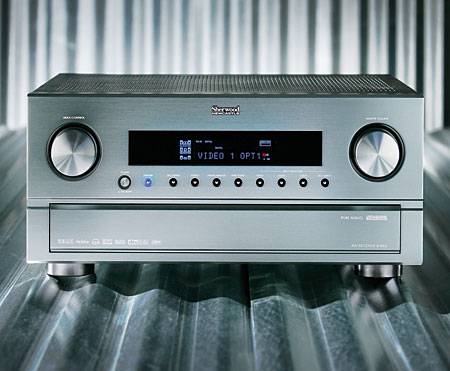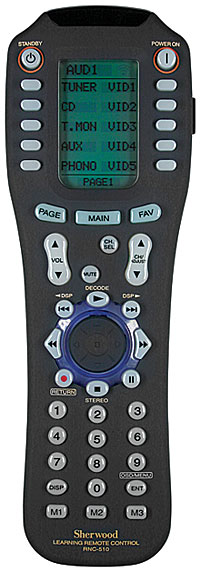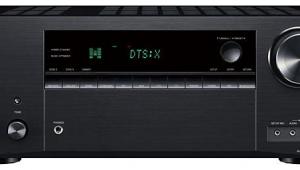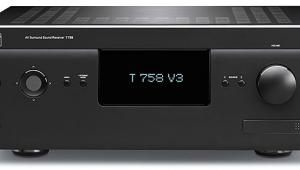Sherwood Newcastle R-965 A/V Receiver
Consumer expectations are a pointed stick. You can almost hear manufacturers of surround receivers going, "Ow, ow, ow! Do you really expect us to provide seven amp channels and a silicon forest of surround modes—and make it all easy to set up?" Yes, yes, and yes.

Most manufacturers keep up with the ever-expanding wish list by regularly turning over models, introducing new ones as often as once a year. Sherwood takes a slightly different route with the new R-965, and, by the way, I call it that to distinguish it from the old R-965. The old one had some qualities and performance parameters worth preserving. So, the new one keeps the old model number and its basic design but throws in some attention-getting new features. Existing units are upgradeable with the new auto-setup and lip-sync functions at no extra charge; adding room equalization costs $100.
The new feature most likely to bridge the chasm between the old model and surround newbies is automatic setup and channel calibration. As with several competing models, you can plug a small microphone into the back of the new model, listen to the receiver spit out test tones, then marvel as it adjusts itself.
The setup routine includes seven-band parametric room equalization that precisely sets both center frequency and width. And it provides lip-sync correction for that awkward moment when you realize that the fancy video chips in your new projector are causing the dialogue to be off.
The Gray Lady Is Beautiful
It would be hard to overstate the attractiveness of the gray matte-aluminum faceplate. Elegant and understated, it puts black boxes and excessively mirror-finished products to shame.
Front panel controls include two large knobs, one for volume, the other for selecting surround modes. You can adjust input selection and most other chores for mundane daily use via the main exposed buttons—which are metallic, pointy, and fun to touch. Sherwood felt that their Pure Audio mode was worth emphasizing with one of these more prominent buttons. It provides a pure analog stereo sound with all video and digital audio circuits shut down.
Flip down a door, and you'll see that a bunch more advanced features are adjustable, including cinema EQ and the full range of Dolby Pro Logic IIx controls. You'll want to adjust them right away because the unit ships with center width and dimension at their minimum settings; I prefer middle settings for both.
The rear panel is well organized. Seven amp channels serve nine pairs of speaker jacks. The dual side-surround jacks let you place one set of speakers at the sides of the room for movie listening and another set closer to the rear for music listening. You can reassign the single set of rear-surround jacks for second-zone use.
One new back-panel option is a USB jack to accept input from a portable music player. Conspicuous in their absence are HDMI, DVI, and FireWire jacks, so, if your video display uses these newer-generation interfaces, it'll have to connect directly to signal sources. Sherwood is wary of the constantly evolving HDMI standard and did not want to ship a product that consumers might regard as "broken." However, for $300, you can add the HDMI-Link, a separate component-to-HDMI transcoding switcher with component in, two HDMI ins, and one HDMI out.
 The remote control is Sherwood's RNC-510, which bears an amazing resemblance to a Universal Remote Control product. It has a black-and-white LCD, pleasantly rounded bubble buttons, and a very logical layout. The center navigation wheel is one piece, which makes hitting enter in the middle a bit tricky.
The remote control is Sherwood's RNC-510, which bears an amazing resemblance to a Universal Remote Control product. It has a black-and-white LCD, pleasantly rounded bubble buttons, and a very logical layout. The center navigation wheel is one piece, which makes hitting enter in the middle a bit tricky.
Power is rated at 140 watts into one channel and 120 into two channels.
The Gray Lady Is Amiable
Next, it was auto-setup time. I mounted the supplied microphone to a tripod in the prime listening position and let 'er rip. She ripped rather loudly—I literally ran for my Howard Leight ear protectors. The manual says to evacuate small children from the room before activating the launch sequence. If I were you, I'd also grab the pets and run for it.
Each channel got two pink-noise tones, one with strong high-frequency content—which made it correspondingly more painful—and a second duller one. After the initial tones made the rounds, a second set ping-ponged back and forth between the front left and right, then between the rear left and right speakers.
Apparently, loud tones produce good results. This was the first receiver that measured my speaker distances and sizes accurately and consistently. My speakers are different distances from the side walls, and that usually puts most auto-setup receivers out of whack in at least one channel, but the Sherwood aced this tricky situation. It correctly identified my full-frequency speakers as large by comparing their low-frequency response to the crossover: Anything under the crossover is labeled large, and anything over it is small. You can set the crossover before or after auto setup, and, if you're curious, you might even use the setup routine to roughly gauge your speakers' in-room bass response.
Once the process is complete, the R-965 stores the channel levels, and the menu lists all of them at zero. So, if you make further manual adjustments, the auto-set levels are your reference points, not the factory-set levels. There is no way to tell what the auto-set levels are. You cannot inspect the EQ settings, either. It may be possible to hear them being set by the second round of test tones, but I wouldn't advise taking the risk.
The Gray Lady Is Up-Front
Since I could only gauge the EQ by listening, I started my primary test disc with the menu in front of me so that I could switch the EQ in and out. The first thing I listen to is always a six-voice a cappella chorus—"Stars in My Crown" from Waterson:Carthy's Common Tongue. When I switched the EQ in, all six voices seemed to take a step toward me. I could differentiate each one of the voices more easily.
 The sound was brighter. Evidently, Sherwood's EQ circuit felt that my heavily damped room needed a little more emphasis in the upper region. I could more easily hear the faint tape hiss surrounding Bill Morrissey's vocal in the first few seconds of "Time to Go Home" from Night Train. And the overall volume level was subjectively louder, although, with EQ, it was more likely that just some frequencies were louder.
The sound was brighter. Evidently, Sherwood's EQ circuit felt that my heavily damped room needed a little more emphasis in the upper region. I could more easily hear the faint tape hiss surrounding Bill Morrissey's vocal in the first few seconds of "Time to Go Home" from Night Train. And the overall volume level was subjectively louder, although, with EQ, it was more likely that just some frequencies were louder.
Eminem's movie vehicle 8 Mile includes several electrifying crowd scenes in which aspiring fictional rappers put themselves on the line. With the EQ off, I felt as though I were listening to a recording of a crowd scene. With the EQ back on, I was in the thick of it, and each heckling voice seemed to be just a few feet away. Here there was no downside—the EQ heightened the emotion of every scene, including both music and dialogue.
Moving to the opposite musical extreme, The Chorus is a French melodrama starring a squadron of boy sopranos. The high voices achieved better separation with EQ but also took on a sharper edge, which led me to drop the volume. I achieved a more mellifluous and unified choral sound and higher volumes with the EQ off.
What would happen if the auto EQ worked in tandem with cinema EQ? Cinema EQ did soften the edge, but not as much as leaving the auto EQ off.
On the whole, I felt that the auto EQ made my system sound more vivid but also made it trickier to use; changing volume as I changed material took greater forethought. Anyhow, my experiments may not be entirely germane. After all, your room acoustics are likely to differ from mine, and the auto EQ might respond in an entirely different way. Of course, you always have the option to do what I did—run the auto setup, listen to the EQ, and then decide whether you want to live with it.
Without EQ, the receiver achieved a fine balance between the leading edge of its midrange and fleshing out the inner detail. Treble was well developed but not hyped. The lower midrange and upper bass were clean, natural, and unsweetened. This receiver doesn't need any fancy tricks to perform well in a decent-sounding room.
The Gray Lady Is Sensible
In an industry infected with the deadly featuritis virus, Sherwood has made judicious choices, updating a good chassis with features that make a difference. The new and improved R-965 delivers reliably strong sound matched by superb looks. Its easy setup should help this receiver play with a broad audience, including both surround neophytes and more critical high-end users.
Highlights
• Old flagship sets sail with new features
• Now has auto setup, seven-band room EQ, and lip sync
• Sounds as impressive as it looks
























































